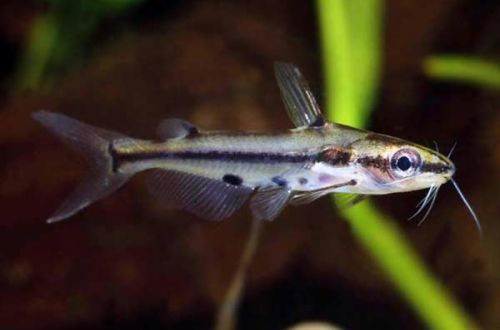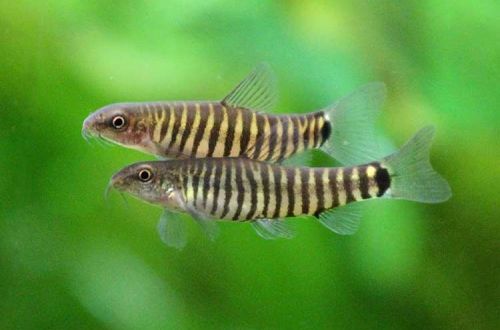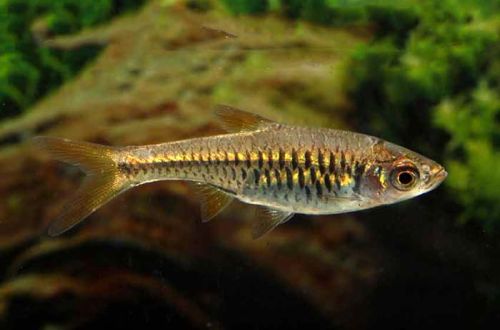
Tetra Schultz
Tetra Timari or Schulz’s Tetra, scientific name Hyphessobrycon haraldschultzi, belongs to the Characins (Characin) family. It is also often referred to as the Red Dwarf Tetra due to its coloration. Bright miniature fish, due to its size, can be kept in nano-aquaria. Not demanding on conditions, easy to breed and able to complement the community of other small freshwater species.

Contents
Habitat
It originates from South America (central and western Brazil) from the Araguaia River basin – the main tributary of the Tocantins in the lower part of the Amazon basin. There is no exact information about the real distribution range of this species; it is quite possible that it is not limited to the Araguaya River. Presumably, the fish lives in small streams and small tributaries, backwaters, oxbow lakes and is not found in the main riverbeds. The habitat contains soft, slightly acidic water with a substrate covered with a layer of fallen leaves and twigs.
Brief information:
- The volume of the aquarium – from 40 liters.
- Temperature – 20-28°C
- Value pH — 5.0–7.0
- Water hardness – 1–10 dGH
- Substrate type – any
- Lighting – subdued
- Brackish water – no
- Water movement is weak
- The size of the fish is about 2 cm.
- Feeding – any food of suitable size
- Temperament – peaceful
- Keeping in a group of 8-10 individuals
Description
Adults reach a length of about 2 cm. Females are slightly larger, and males are more colorful, but in general, sex differences are not significant. The fish have a bright red color, the body pattern consists of only one dark speck behind the gill covers. The dorsal fin has yellow, black and white markings.
Food
Omnivorous species, accepts most popular food in the aquarium trade of a suitable size. For example, a daily diet may consist of dry foods in the form of flakes, granules. An excellent addition to the diet will be live or frozen small invertebrates such as brine shrimp, daphnia.
Maintenance and care, arrangement of the aquarium
The optimal size of the aquarium for a flock of 8-10 fish starts from 40 liters. Tetra Timari will look good among thickets of plants in dim lighting. In the design, sandy soil and various sizes of driftwood are also usually used.
An additional and at the same time useful element of decor will be the dried leaves of some trees. With their gradual decomposition, the same processes occur as in nature with fallen leaves, tannins are released, giving the water a chemical composition close to that found in natural reservoirs. In addition, the leaves serve as a source for the appearance of colonies of microorganisms, for example, shoe ciliates – a valuable secondary food for fry.
Successful long-term maintenance depends on a number of factors, the most important of which include water quality. Regular aquarium maintenance procedures and equipping it with the necessary equipment will maintain stable water conditions within an acceptable range of temperatures and hydrochemical values.
It is worth remembering that such small fish do not respond well to excessive water movement, and since its main cause is the operation of filters, models that do not cause a strong internal current should be selected.
Behavior and Compatibility
Peaceful friendly fish, compatible with other species of comparable size. It is recommended to maintain a flock size of at least 10 individuals. In this case, the principle of growth – the more the better.
Breeding / breeding
For fish that have been living in an artificial environment for generations, the incentive to spawn will be simply being in suitable conditions. There is no breeding season. If the flock is large, then fry can appear almost every month.
During spawning, females ready for breeding scatter their eggs among thickets of plants or in open space directly on the ground. Parental instincts are not developed, so there is no care for the offspring, moreover, on occasion, Tetra Timari will definitely eat his own fry. To protect the brood, fertilized eggs are transferred to a separate tank filled with water from the main tank to recreate identical water conditions.
In the first days of life, the fry feed on the remains of their yolk sac, but as they grow, they begin to need microscopic food such as ciliates or a specialized powdered product.
Fish diseases
Diseases inherent in this particular species of fish were not noted. When kept in suitable conditions (high water quality, balanced diet, non-conflict neighbors, etc.), health problems are not observed. The most common cause of disease is the deterioration of conditions leading to immune suppression, which makes the fish susceptible to infections that are invariably present in the surrounding area. When the first signs of an illness are detected (lethargy, exhaustion, refusal of food, lowered fins, etc.), it is necessary to immediately check the main parameters of the water. Often, the restoration of acceptable living conditions contributes to self-healing, but if the fish is too weak or has received obvious damage, medical treatment will be required. For more information on symptoms and treatments, see the Aquarium Fish Diseases section.





